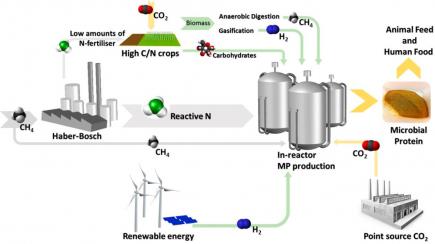The next revolution in food will be microbes

(30-03-2018)
A recent study on microorganisms as a source of protein has been awarded as Top Feature Article of 2017 by the American Chemical Society.
A recent study, published in Environmental Science & Technology on microorganisms as a source of protein has been awarded as Top Feature Article of 2017 by the American Chemical Society. The study has been published by The University of Queensland, Ghent University and the Potsdam institute of Climate Impact Research.
Today’s agricultural practice of growing crops for animal production and human food threatens the sustainability of the planet, both in terms of nitrogen pollution and in terms of energy requirements.
Microorganisms as an alternative, effective source of protein can help to avoid these planetary nitrogen burdens. This means that nitrogen, produced e.g. from Haber Bosch processes, can be used directly to grow microorganisms in reactors. These microorganisms contain up to 75% protein (microbial protein) that can be harvested and used as feed or food after drying and processing. This approach bypasses land-based agriculture and thus avoids significant nitrogen losses to the environment.
Almost double as efficient
In their feature article published in the leading journal Environmental Science & Technology, the researchers show that the efficiency of the nitrogen cycle can be improved from 4% to 10% by feeding cattle with microbial protein. When this protein is used directly for human food, the efficiency even increases to 43%.
This approach can thus be of major impact worldwide, decreasing the burdens on agriculture leading to decreased land usage without needing genetic engineering to safeguard feed and food supply for the generations to come.
Moreover, microbes are very versatile in terms of feedstock that can be used to grow them. They can even be grown using CO2 and H2 coming from renewable electricity.
Top Feature Article 2017
On March 20th, the American Chemical Society announced at its General Meeting that the article describing these impacts, with as co-authors from the faculty of Bioscience Engineering at Ghent University Korneel Rabaey, Silvio Matassa and Willy Verstraete, was voted as Top Feature Article of 2017.